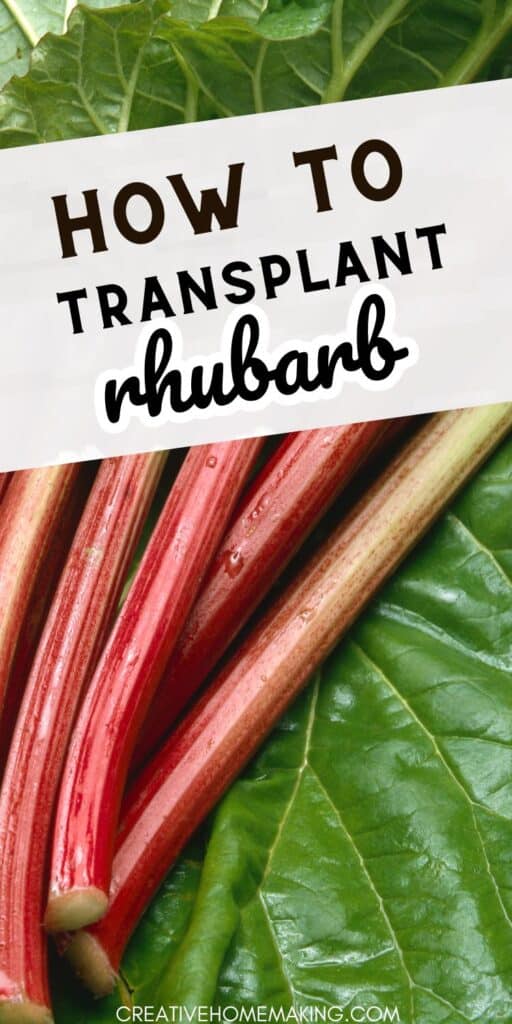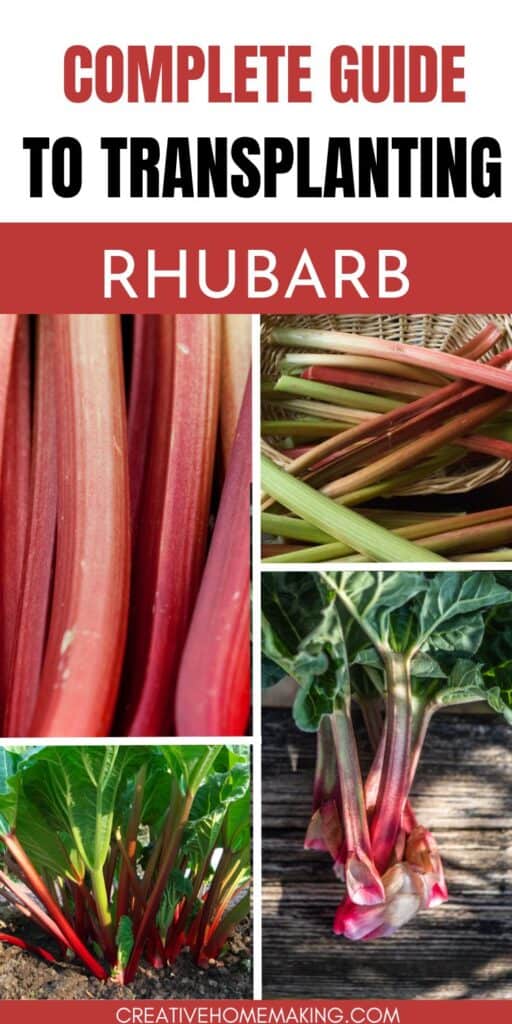Transplanting rhubarb is a simple process that can be done in the early spring or fall. Rhubarb is a hardy perennial vegetable that can thrive in most soil types and requires little maintenance once established. Transplanting rhubarb is a great way to rejuvenate an old plant or to move it to a new location.
This post may contain affiliate links.
Before transplanting rhubarb, it is important to choose a location that receives full sun and has well-draining soil. Rhubarb prefers soil that is rich in organic matter and has a pH between 6.0 and 6.8.
Related Article: Rhubarb Crisp Recipe: A Delicious Dessert for Spring
Once you have chosen a location, prepare the soil by adding compost or well-rotted manure to the planting area.
To transplant rhubarb, start by digging up the entire plant, making sure to keep as much of the root system intact as possible. Divide the plant into smaller sections, each with a healthy root system and at least one bud.
Replant the sections in the prepared soil, making sure to plant them at the same depth they were originally growing. With proper care, the transplanted rhubarb should start producing new growth within a few weeks.
Related Article: How to Freeze Rhubarb: A Quick and Easy Guide
Understanding Rhubarb
If you’re considering transplanting rhubarb, it’s important to understand this unique perennial vegetable. Rhubarb is a vegetable that is known for its large, green or red leaves and edible stalks.
It’s a hardy plant that can survive in a variety of conditions, making it a great addition to any garden.
Rhubarb is a vegetable that is typically grown for its stalks, which are used in a variety of sweet and savory dishes. These stalks are typically a bright red color, but some varieties may have green stalks.
The leaves of the rhubarb plant are not edible and can be toxic if ingested, so it’s important to only consume the stalks.
Related Article: Easy Rhubarb Butter
One of the unique aspects of rhubarb is that it is a perennial vegetable, meaning that it will continue to grow and produce stalks year after year. This makes it a great investment for any gardener who is looking for a long-term addition to their garden.
When transplanting rhubarb, it’s important to choose a location that receives plenty of sunlight and has well-draining soil. Rhubarb plants prefer soil that is rich in organic matter, so it’s a good idea to amend the soil with compost or other organic material before planting.
Overall, rhubarb is a unique and versatile vegetable that can add a pop of color and flavor to any garden or dish. By understanding the basics of this plant, you can ensure that your transplanting efforts are successful and that you can enjoy fresh rhubarb for years to come.
Related Article: How to Divide Rhubarb: A Simple Guide
Preparing for Transplanting
Transplanting rhubarb can be a great way to ensure healthy plants and a bountiful harvest. Before you begin, make sure you have enough space in your yard or vegetable garden for the rhubarb plants to grow.
To prepare for transplanting, start by selecting a site that receives full sun or partial shade. Rhubarb plants prefer well-drained soil that is rich in organic matter, so consider adding compost, mulch, or manure to the soil before planting.
Related Article: Trimming or Pruning a Rhododendron
To remove the rhubarb plant from its current location, use a garden fork, shovel, or spade to dig around the plant and loosen the soil. Be careful not to damage the roots in the process.
Once the plant has been removed, trim any damaged or dead roots and leaves. You can also divide the plant into smaller sections if you want to propagate it.
Before transplanting the rhubarb, make sure to dig a hole that is large enough to accommodate the root system. Place the plant in the hole and backfill with soil, making sure to tamp the soil down around the plant to remove any air pockets.
Water the newly transplanted rhubarb plant thoroughly and add a layer of mulch to help retain moisture and suppress weeds. With proper care, your rhubarb plant should thrive in its new location and provide you with a delicious harvest for years to come.
Related Article: How to Divide and Transplant Iris Bulbs
The Transplanting Process
Transplanting rhubarb is a straightforward process that requires some preparation and care. Here is a step-by-step guide on how to transplant rhubarb successfully.
Timing
The best time to transplant rhubarb is in the fall, after the plant has gone dormant. This will give the plant enough time to establish its root system before the next growing season. However, you can also transplant rhubarb in the spring, as soon as the soil is workable.
Related Article: How to Transplant Raspberries: A Step-by-Step Guide
Preparing the Plant
Before transplanting, dig around the plant to loosen the soil and expose the root system. Carefully lift the plant out of the ground, taking care not to damage the root ball or root clump. If the plant is large, you may need to divide it into smaller sections to make it easier to handle.
Transplanting
Dig a hole in the new location that is large enough to accommodate the root system. Make sure the hole is deep enough to cover the crown of the plant with about an inch of soil.
Place the plant in the hole, making sure the buds are facing upwards. Backfill the hole with soil, making sure to firm it around the plant to eliminate air pockets.
Related Article: When to Pick Rhubarb: A Guide to Harvesting
Aftercare
Water the plant thoroughly after transplanting to help settle the soil around the roots. Keep the soil moist but not waterlogged for the first few weeks after transplanting. Mulch around the plant to help retain moisture and suppress weeds.
Related Article: Pruning Raspberries in the Spring: A Step by Step Guide
Caring for Transplanted Rhubarb
Transplanting rhubarb can be a daunting task, but it is necessary if you want to grow healthy rhubarb. After transplanting, it is important to care for your rhubarb to ensure that it grows properly. Here are some tips to help you care for your transplanted rhubarb:
Care
Rhubarb requires minimal care, but it is important to keep an eye on it to ensure that it is growing properly. You should remove any weeds that grow around your rhubarb plants to prevent them from competing for nutrients.
Related Article: How to Transplant Hollyhocks
Watering
Watering your transplanted rhubarb is important to ensure that it grows properly. Rhubarb requires regular watering, especially during dry spells. You should water your rhubarb once a week, but make sure that the soil is not too wet.
Growth
Rhubarb is a fast-growing plant, and it can grow up to 2 feet tall. It is important to keep an eye on your rhubarb to ensure that it is growing properly. If your rhubarb is not growing properly, it may be a sign that it is not getting enough nutrients.
Related Article: How to Transplant Aloe Vera: A Beginner’s Guide
Healthy Rhubarb
To keep your rhubarb healthy, you should fertilize it once a year. You can use a general-purpose fertilizer or a fertilizer specifically designed for rhubarb. You should also prune your rhubarb regularly to ensure that it grows properly.
Fertility
Rhubarb requires fertile soil to grow properly. Before transplanting your rhubarb, you should prepare the soil by adding compost or manure. You should also test the soil to ensure that it has the right pH level.
Nutrients
Rhubarb requires nutrients to grow properly. You should fertilize your rhubarb once a year to ensure that it gets the nutrients it needs. You can use a general-purpose fertilizer or a fertilizer specifically designed for rhubarb.
By following these tips, you can ensure that your transplanted rhubarb grows properly and remains healthy.
Propagation of Rhubarb
If you want to grow more rhubarb plants, you can propagate them easily. Rhubarb can be propagated through clumps or seeds. Here’s how you can do it:
Propagation through Rhubarb Clumps
Propagating rhubarb through clumps is the easiest and most common method. You can do this in early spring or late fall. Here are the steps:
- Dig up an established rhubarb plant.
- Using a sharp knife, divide the clump into smaller sections. Each section should have at least one healthy-looking eye.
- Replant the sections in a new location, making sure to bury the crown just below the soil surface. Water the newly transplanted clumps thoroughly.
Propagation through Rhubarb Seeds
Propagation through seeds is a bit more challenging, but it can be done. Here are the steps:
- In the fall, let a few of your rhubarb plants go to seed. The seed stalks will grow tall and produce small, greenish-yellow flowers.
- Once the flowers have dried up and turned brown, cut the seed stalks and let them dry for a few days.
- Rub the seed stalks between your hands to release the seeds.
- Plant the seeds in a seed tray or small pots filled with seed-starting mix. Keep the soil moist and warm until the seeds germinate.
- Once the seedlings have developed their second set of leaves, transplant them into larger pots or directly into the garden.
Remember, rhubarb plants take a few years to become established, so be patient. With proper care, your new rhubarb plants will provide you with delicious stalks for years to come.
Frequently Asked Questions
When is the best time to transplant rhubarb?
The best time to transplant rhubarb is in the fall or early spring when the plant is dormant. This will give the plant time to establish itself before the growing season begins.
How do you split and transplant rhubarb?
To split and transplant rhubarb, dig up the entire plant and carefully separate the crowns into smaller sections. Each section should have at least one healthy bud and a good amount of roots. Replant the sections in well-draining soil, leaving the crown just above the soil level.
Can rhubarb be dug up and moved?
Yes, rhubarb can be dug up and moved to a new location. However, it is best to do this when the plant is dormant in the fall or early spring.
Can you transplant a mature rhubarb plant?
Yes, mature rhubarb plants can be transplanted, but it may take longer for them to establish themselves in their new location. Be sure to dig up as much of the root system as possible to minimize shock to the plant.
Does rhubarb like to be moved?
No, rhubarb does not like to be moved and may take some time to recover from the shock of transplanting. It is important to provide the plant with plenty of water and nutrients during this time.
How deep are rhubarb roots?
Rhubarb roots can grow quite deep, up to 3 feet or more, so it is important to dig a deep hole when transplanting to ensure the roots have enough room to grow.
Follow my gardening board on Pinterest.





We transplanted rhubarb-one in late fall last year and one in February tis year. Both transplants are doing well. Is it OK to pick stalks this spring and summer?